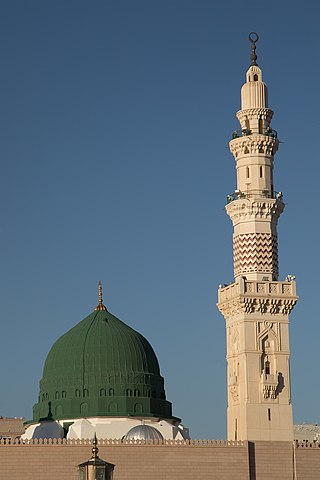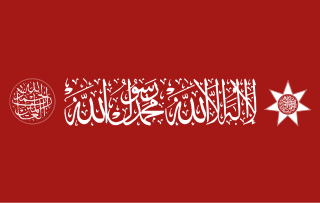
Mecca is the capital of Mecca Province in the Hejaz region of western Saudi Arabia; it is the holiest city according to Islam. It is 70 km (43 mi) inland from Jeddah on the Red Sea, in a narrow valley 277 m (909 ft) above sea level. Its metropolitan population in 2022 was 2.4 million, making it the third-most populated city in Saudi Arabia after Riyadh and Jeddah. Around 44.5% of the population are Saudi citizens and around 55.5% are Muslim foreigners from other countries. Pilgrims more than triple the population number every year during the Ḥajj pilgrimage, observed in the twelfth Hijri month of Dhūl-Ḥijjah. With over 10.8 million international visitors in 2023, Mecca was one of the ten most visited cities in the world.

Medina, officially Al-Madinah al-Munawwarah and also commonly simplified as Madīnah or Madinah, is the capital of Medina Province in the Hejaz region of western Saudi Arabia. It is one of the oldest and most important places in Islamic history. One of the most sacred cities in Islam, the population as of 2022 is 1,411,599, making it the fourth-most populous city in the country. Around 58.5% of the population are Saudi citizens and 41.5% are foreigners. Located at the core of the Medina Province in the western reaches of the country, the city is distributed over 589 km2 (227 sq mi), of which 293 km2 (113 sq mi) constitutes the city's urban area, while the rest is occupied by the Hejaz Mountains, empty valleys, agricultural spaces and older dormant volcanoes.

The Hejaz is a region that includes the majority of the west coast of Saudi Arabia, covering the cities of Mecca, Medina, Jeddah, Tabuk, Yanbu, Taif and Baljurashi. It is thus known as the "Western Province", and it is bordered in the west by the Red Sea, in the north by Jordan, in the east by the Najd, and in the south by the Region of 'Asir. Its largest city is Jeddah, which is the second-largest city in Saudi Arabia, with Mecca and Medina, respectively, being the fourth- and fifth-largest cities in the country.

The Prophet's Mosque is the second mosque built by the Islamic prophet Muhammad in Medina, after the Quba Mosque, as well as the second largest mosque and holiest site in Islam, after the Masjid al-Haram in Mecca, in the Saudi region of the Hejaz. The mosque is located at the heart of Medina, and is a major site of pilgrimage that falls under the purview of the Custodian of the Two Holy Mosques.

The Quraysh or Qureshi is an Arab tribe that inhabited and used to control Mecca and the Kaaba. Comprising ten main clans, it includes the Hashim clan into which the Islamic prophet Muhammad was born. By 600 CE, the Quraysh had become wealthy merchants, dominating trade between the Indian Ocean, East Africa, and the Mediterranean. They ran caravans to Gaza and Damascus in summer, and Yemen in winter. They also mined and pursued other enterprises on these routes, placing business interests first.

The Quba Mosque is a mosque located in Medina, in the Hejaz region of Saudi Arabia, first built in the lifetime of the Islamic prophet Muhammad in the 7th century C.E. It is thought to be the first mosque in the world, established on the first day of Muhammad's emigration to Medina. Its first stone is said to have been laid by the prophet, and the structure completed by his companions. The mosque was subsequently modified across the centuries until the 1980s, when it was completely replaced by a new building that stands today.

Jannat al-Baqī is the oldest and first Islamic cemetery of Medina located in the Hejazi region of present-day Saudi Arabia. It is also known as Baqi al-Gharqad.

Abd Allah ibn al-Zubayr ibn al-Awwam was the leader of a caliphate based in Mecca that rivaled the Umayyads from 683 until his death.
There were several Arabian tribes that interacted with Muhammad.
The Banu Sulaym is an Arab tribe that dominated part of the Hejaz in the pre-Islamic era. They maintained close ties with the Quraysh of Mecca and the inhabitants of Medina, and fought in a number of battles against the Islamic prophet Muhammad before ultimately converting to Islam before his death in 632. They took part in the Muslim conquest of Syria, and established themselves in the Jazira, while part of the tribe remained in the Hejaz. During the early Muslim period, the tribe produced notable generals such as Safwan ibn Mu'attal, Abu'l-A'war and Umayr ibn al-Hubab. Those who remained in Arabia were largely absorbed by the Banu Harb of Yemen beginning in the 9th century, while those in Syria and the Jazira were expelled to Upper Egypt by the Fatimid Caliphs in the late 10th century for supporting the Qarmatians. In the mid-11th century, a prolonged famine in Egypt prompted the tribe to migrate westward with the Banu Hilal into Libya. There, the Sulaym and its sub-tribes established themselves mainly in Cyrenaica, where to the present day, many of the Arab tribes of that region trace their descent to the Sulaym.

The holiest sites in Islam are located in the Arabian Peninsula. While the significance of most places typically varies depending on the Islamic sect, there is a consensus across all mainstream branches of the religion that affirms two cities as having the highest degree of holiness, in descending order: Mecca, and Medina. Mecca's Al-Masjid al-Haram, Al-Masjid an-Nabawi in Medina are all revered by Muslims as sites of great importance.

The Ansar or Ansari are the local inhabitants of Medina who took the Islamic prophet Muhammad and his followers into their homes when they fled from Mecca during the hijra. They belonged to the tribes of Banu Khazraj and Banu Aus.

The destruction of heritage sites associated with early Islam is an ongoing phenomenon that has occurred mainly in the Hejaz region of western Saudi Arabia, particularly around the two holiest cities of Islam, Mecca and Medina. The demolition has focused on mosques, burial sites, homes and historical locations associated with the Islamic prophet Muhammad, his companions, and many of the founding personalities of early Islamic history by the Saudi government. In Saudi Arabia, many of the demolitions have officially been part of the continued expansion of the Masjid al-Haram at Mecca and the Prophet's Mosque in Medina and their auxiliary service facilities in order to accommodate the ever-increasing number of Muslims performing the pilgrimage (hajj).

The Green Dome is a green-coloured dome built above the tombs of the Islamic prophet Muhammad and the early Rashidun Caliphs Abu Bakr and Omar, which used to be the Noble Chamber of Aisha. The dome is located in the southeast corner of Al-Masjid al-Nabawi in Medina, present-day Saudi Arabia. Millions visit it every year, since it is a tradition to visit the mosque after or before the pilgrimage to Mecca.

Sunni Muslims and Shia Muslims agree on the three holiest sites in Islam being, respectively, the Masjid al-Haram, in Makkah; the Al-Masjid an-Nabawi, in Medina; and the Al-Masjid Al-Aqsa, in Jerusalem.

Both Sunni Muslims and Shia Muslims agree on the three Holiest sites in Islam being, respectively, the Masjid al-Haram, in Mecca; the Al-Masjid an-Nabawi, in Medina; and Al-Masjid al-Aqsa, in Jerusalem.

The Sharifate of Mecca or Emirate of Mecca was a state, non-sovereign for much of its existence, ruled by the Sharif of Mecca. A sharif is a descendant of Hasan ibn Ali, Muhammad's grandson. In Western sources, the prince of Mecca was known as Grand Sherif, but Arabs have always used the appellation "Emir".

The Vilayet of the Hejaz refers to the Hejaz region of Arabia when it was administered as a first-level province (vilayet) of the Ottoman Empire. At the beginning of the 20th century, it reportedly had an area of 96,500 square miles (250,000 km2). The Hejaz included all land from the southern border of the Vilayet of Syria, south of the city of Ma‛an, to the northern border of the Vilayet of Yemen, north of the city of Al Lith.
The following is a timeline of the history of the city of Mecca, Saudi Arabia.

Mosque of Al-Ghamamah is one of the oldest mosques in Medina, Saudi Arabia, located in the place believed to be where the Islamic prophet Muhammad performed an Eid prayer in the year 631. It is also narrated that Muhammad offered Salat ul-Istasqa when the city of Madina faced a shortage of rain. For a while, this mosque was closed for daily prayers because of its proximity to the Al-Masjid an-Nabawi. However quite recently it has been reopened for the worshipers for praying. Five times prayers are held in this mosque now with an internal sound system to avoid the clash of sounds from the Prophet's Mosque. The mosque is one of the historical relics of Medina.
















